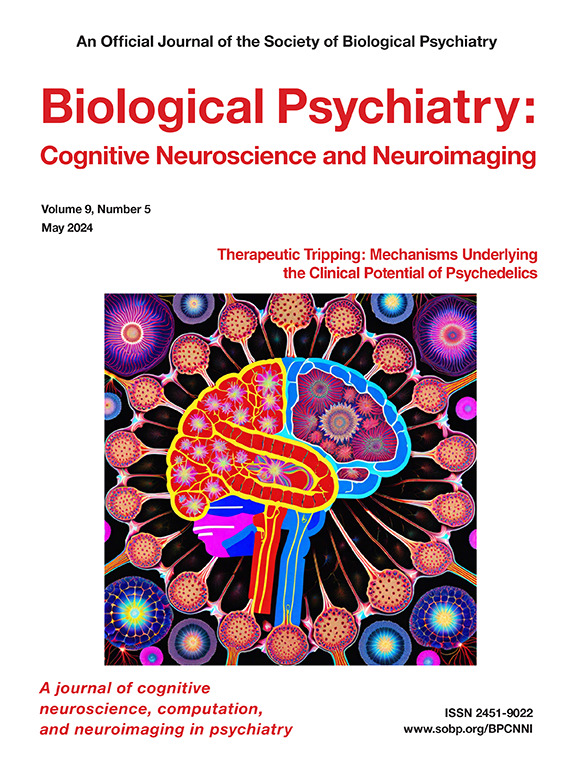杏仁内侧 tau 与临床前阿尔茨海默病的情绪症状有关。
IF 4.8
2区 医学
Q1 NEUROSCIENCES
Biological Psychiatry-Cognitive Neuroscience and Neuroimaging
Pub Date : 2024-12-01
DOI:10.1016/j.bpsc.2024.07.012
引用次数: 0
摘要
背景:阿尔茨海默病(AD)患者的杏仁核早期会出现tau沉积,并参与社交和情感处理,但杏仁核tau与AD早期神经精神症状之间的关系尚不清楚。我们试图确定在临床前阿兹海默症队列中是否能检测到杏仁核中的局灶性tau结合和异常的杏仁核连接,并确定这些与自我报告的情绪症状之间的关系:我们对A4研究中的598人(淀粉样蛋白阳性者347人(58%为女性),淀粉样蛋白阴性者251人(62%为女性);分为tau PET队列和fMRI队列)进行了研究。在 tau PET 队列中,我们使用杏仁核分割来检查杏仁核三个功能分区的代表性核团。我们分析了临床前AD患者杏仁核分部特异性tau结合的组间差异。我们对 fMRI 队列中的每个分区进行了基于种子的功能连接分析。最后,我们对相关神经影像生物标志物与焦虑和抑郁评分进行了探索性事后相关分析:结果:淀粉样蛋白阳性者杏仁核内侧和外侧的 tau 结合增加,这些区域的 tau 结合与情绪症状相关。在杏仁核各分区中,淀粉样蛋白阳性者杏仁核与其他颞区、脑岛和眶额皮层的区域连接性相对较高,但杏仁核内侧与后脾皮层的连接性较低。杏仁核内侧到后脾的连通性与焦虑症状呈负相关,后脾tau也与焦虑症状呈负相关:我们的研究结果表明,杏仁核中临床前tau沉积和相关功能连接的变化可能与AD患者的早期情绪症状有关。本文章由计算机程序翻译,如有差异,请以英文原文为准。
Medial Amygdalar Tau Is Associated With Mood Symptoms in Preclinical Alzheimer’s Disease
Background
While the amygdala receives early tau deposition in Alzheimer’s disease (AD) and is involved in social and emotional processing, the relationship between amygdalar tau and early neuropsychiatric symptoms in AD is unknown. We sought to determine whether focal tau binding in the amygdala and abnormal amygdalar connectivity were detectable in a preclinical AD cohort and identify relationships between these and self-reported mood symptoms.
Methods
We examined 598 individuals (347 amyloid positive [58% female], 251 amyloid negative [62% female] subset in tau positron emission tomography and functional magnetic resonance imaging cohorts) from the A4 (Anti-Amyloid Treatment in Asymptomatic AD) Study. In the tau positron emission tomography cohort, we used amygdalar segmentations to examine representative nuclei from 3 functional divisions of the amygdala. We analyzed between-group differences in division-specific tau binding in the amygdala in preclinical AD. We conducted seed-based functional connectivity analyses from each division in the functional magnetic resonance imaging cohort. Finally, we conducted exploratory post hoc correlation analyses between neuroimaging biomarkers of interest and anxiety and depression scores.
Results
Amyloid-positive individuals demonstrated increased tau binding in the medial and lateral amygdala, and tau binding in these regions was associated with mood symptoms. Across amygdalar divisions, amyloid-positive individuals had relatively higher regional connectivity from the amygdala to other temporal regions, the insula, and the orbitofrontal cortex, but medial amygdala to retrosplenial cortex connectivity was lower. Medial amygdala to retrosplenial connectivity was negatively associated with anxiety symptoms, as was retrosplenial tau.
Conclusions
Our findings suggest that preclinical tau deposition in the amygdala and associated changes in functional connectivity may be related to early mood symptoms in AD.
求助全文
通过发布文献求助,成功后即可免费获取论文全文。
去求助
来源期刊

Biological Psychiatry-Cognitive Neuroscience and Neuroimaging
Neuroscience-Biological Psychiatry
CiteScore
10.40
自引率
1.70%
发文量
247
审稿时长
30 days
期刊介绍:
Biological Psychiatry: Cognitive Neuroscience and Neuroimaging is an official journal of the Society for Biological Psychiatry, whose purpose is to promote excellence in scientific research and education in fields that investigate the nature, causes, mechanisms, and treatments of disorders of thought, emotion, or behavior. In accord with this mission, this peer-reviewed, rapid-publication, international journal focuses on studies using the tools and constructs of cognitive neuroscience, including the full range of non-invasive neuroimaging and human extra- and intracranial physiological recording methodologies. It publishes both basic and clinical studies, including those that incorporate genetic data, pharmacological challenges, and computational modeling approaches. The journal publishes novel results of original research which represent an important new lead or significant impact on the field. Reviews and commentaries that focus on topics of current research and interest are also encouraged.
 求助内容:
求助内容: 应助结果提醒方式:
应助结果提醒方式:


